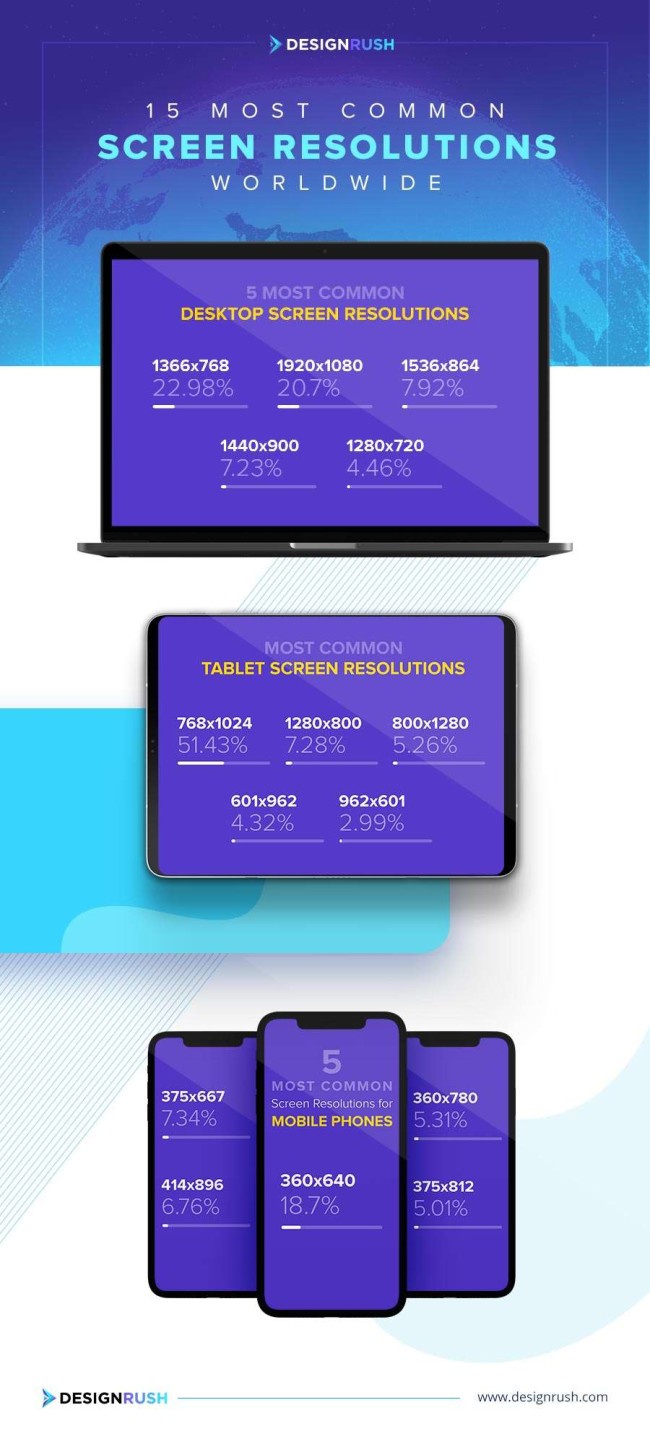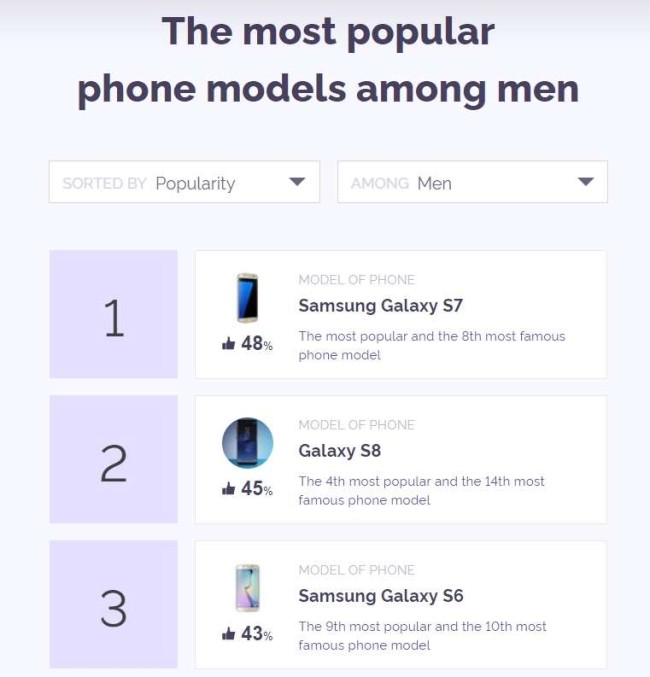The most common screen resolutions for web design purposes are the ones features in this article, and we’ll take you through the most common ones responsive websites should be designed for, as done by the best website development companies.
Read on to find out whether you should opt for a mobile-first or responsive design.
Table of Contents
- 5 Most Common Desktop Screen Resolutions Worldwide
- 5 Most Common Mobile Screen Resolutions Worldwide
- 5 Most Common Tablet Screen Resolutions Worldwide
- The Top 15 Most Common Screen Resolutions In The US
- Why Website Dimensions Matter In Web Design And Development
- How To Decide Which Website Dimensions To Use, i.e Which Screen Resolution To Optimize Your Website For
- Responsive vs. Mobile-First Web Design: Which One To Opt For
- What Are The Best Website Dimensions To Use In 2023?
- How To Check Whether Your Website Is Mobile-Friendly?
- Takeaways On Website Dimensions
5 Most Common Desktop Screen Resolutions Worldwide
According to StatCounter, the most used desktop screen resolutions from July 2022 - July 2023 are:
- 1920x1080 (22.7%)
- 1366x768 (14.47%)
- 1536x864 (10.41%)
- 1440x900 (6.61%)
- 1600x900 (3.8%)
5 Most Common Mobile Screen Resolutions Worldwide
When it comes to the most common screen resolutions of smartphones, between July 2022 and July 2023, designers around the globe preferred to use the following sizes:
- 360x800 (11.65%)
- 390x844 (7.26%)
- 414x896 (5.66%)
- 393x873 (5.16%)
- 328x926 (3.84%)
5 Most Common Tablet Screen Resolutions Worldwide
Between July 2022 and July 2023, the most common tablet screen resolutions worldwide were:
- 768x1024 (26.96%)
- 810x1080 (9.68%)
- 1280x800 (6.76%)
- 800x1180 (5.04%)
- 962x601 (2.99%)

The Top 15 Most Common Screen Resolutions In The US
Here are the most common screen sizes that you should opt for in 2023:
Most Common Desktop Screen Resolutions In The US
Based on the data of StatCounter, between July 2022 and July 2023, the most common screen resolutions for desktop in the US were:
- 1920x1080 (19.57%)
- 1366x768 (14.88%)
- 1440x900 (9.18%)
- 1536x864 (7.22%)
- 1024x768 (4.73%)
Most Common Mobile Screen Resolutions In The US
During the same period of time, the most common screen resolutions for mobile phones in the US were:
- 414x896 (19.44%)
- 375x667 (13.67%)
- 375x812 (12.3%)
- 414x736 (8.91%)
- 360x640 (8.21%)
Most Common Tablet Screen Resolutions In The US
Designers in the US preferred different screen resolutions of tablets and created webpage sizes for the following dimensions:
- 768x1024 (55.64%)
- 1280x800 (5.74%)
- 800x1280 (5.31%)
- 601x962 (5.14%)
- 962x601 (3.2%)

Why Website Dimensions Matter In Web Design And Development
According to StatCounter, the traffic share in July 2023, was generated through:
- Mobile (55.67%)
- Desktop (42.4%)
- Tablet (1.93%)
The environment of web interaction is diverse. And to ensure outstanding user experience across all devices, businesses are bound to invest in mobile responsive design.
Wireframing is the stage at which web designers craft both desktop and mobile experiences, distributing the elements for both views.
Most designers use one standard desktop and one standard mobile resolution to scale designs and ensure smooth UX across devices.
The brands that want a truly cutting-edge website and user experience will take even more aspects in mind in the wireframing stage including:
- Desktop, tablet, mobile views
- Portrait and landscape views
- Browsers
How To Decide Which Website Dimensions To Use, i.e Which Screen Resolution To Optimize Your Website For
The first step to determining the best web dimensions to focus on is to find out what mobile screen sizes your target market owns.
Start by looking at your audience’s demographics.
Demographics can dictate what devices your potential clients use to access your website.
Here’s what to look at:
- Age: Research the most popular device brand/model among the age group you are targeting. YouGov is a great, up-to-date resource that tracks these trends and filters
- Gender: Resources like YouGov can also allow you to filter the most popular devices among genders, allowing you to cross-match the devices by age-group and target gender.

- Location: Going into a more granular, in-depth insight, adding local trends helps you sharpen your focus.
- Income: If you are targeting high-income audiences, your website will have to be on-point and perform smoothly on the latest, most cutting-edge devices.
Responsive vs. Mobile-First Web Design: Which One To Opt For
Mobile devices (excluding tablets) account for half of the worldwide web traffic. In fact, in January 2023, smartphones generated almost 57% of web page views on a global level.
These numbers make businesses invest in websites that work well on smartphones.
However, one of the biggest concerns is whether they should invest in responsive or mobile-first web design.
Designers create a responsive website design to fit the desktop, at a maximum required resolution, and then they adjust it for smaller screens.
The process of developing mobile-first design, on the other hand, is very similar to designing a mobile app where web designers later adapt it for desktop or tablet usage.
In this case, the overall design fits mobile devices perfectly, and it scales up (rather than down) to fill in the desktop view.
With the growing mobile usage, we can see that B2B buyers are not really different from the B2C ones.
This is why 65.8% of B2B businesses plan to improve the mobile experiences of their websites.
What Are The Best Website Dimensions To Use In 2023?
This is a complicated question that has a simple answer.
There is no one size fits all.
What works best for other websites may not work for you.
And instead of focusing on the best web page dimensions and creating web pages for various devices, you should design for your audience first.
Today it is all about user experience, and you should make sure you get a responsive design to keep your prospective clients satisfied.
How To Check Whether Your Website Is Mobile-Friendly?

Google offers a free mobile-friendly test where you can discover whether your web pages are easy to use on mobile devices.
Simply add your website’s URL or code and you will find out how your page scores.
In a matter of a few seconds, you will get your results and learn whether your designers delivered you the design they promised.
Takeaways On Website Dimensions
Website dimensions and webpage sizes matter because a single poor on-site experience can repel your users once and for all.
Considering the fact that users access the web from mobile devices including smartphones and tablets as well, there are two types of web design you can choose from to optimize your website for different devices:
- Mobile responsive
- Mobile-first
No matter which dimensions you choose, make sure you design for your audience and consider their:
- Age
- Gender
- Location
- Income
This will help you improve user experience, increase dwell time and boost search engine rankings.









